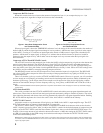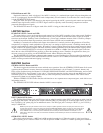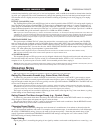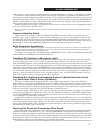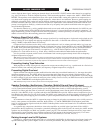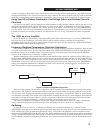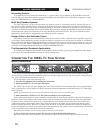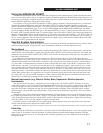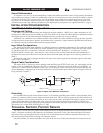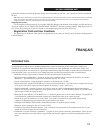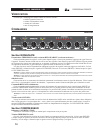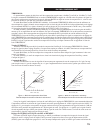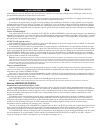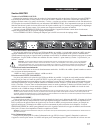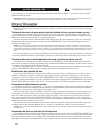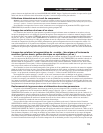
Sound Reinforcement
To compress a live mix or to protect loudspeakers, connect the 166XL between the source (mixing board or distribution
amp) and the power amp(s). If multi-way loudspeakers with low-level electronic crossovers are used, the 166XL(s) should
go after the crossover(s). For a stereo system, you can separately stereo couple the two high band crossovers, low band
crossovers, etc. If limitations require that you use a single 166XL channel before a crossover, adding an equalizer to the
sidechain may provide some additional protection to your high frequency components (see “Speaker Protection,” page 8).
INSTALLATION CONSIDERATIONS
Input/Output Cable Configurations
Hookups and Cabling
The 166XL is a balanced (differential) unit designed for nominal +4dBu or -10dBV levels; inputs and outputs are 1/4”
tip/ring/sleeve (TRS) phone jacks and XLR-type jacks. The 166XL can be used with either balanced or unbalanced sources
and outputs can be used with either balanced or unbalanced loads, provided you use proper cabling.
A balanced line is defined as two-conductor shielded cable with the two center conductors carrying the same signal but
of opposite polarity with respect to ground. An unbalanced line is generally a single-conductor shielded cable with the cen-
ter conductor carrying the signal and the shield at ground potential.
Input Cable Configurations
The 166XL has an actual input impedance of >40k" in balanced or unbalanced configurations. This makes the 166XL
audio input suitable for use with virtually any source impedance, low or high. The 166XL’s input jacks are wired in paral-
lel. The phone jack TIP (+) connection is internally wired to the XLR pin 2, the RING (-) is wired to pin 3, and the
SLEEVE (shield) is wired to pin 1. Note that pins 2 and 3 are the reverse of certain older dbx and other manufacturer’s
equipment, but if the same connection is used at both the input and the output, the signal will be correctly polarized (“in
phase”).
Reversing the input wires to the input terminals will result in the output signal polarity being the opposite of the input
signal (“180 out of phase”).
Output Cable Considerations
The model 166XL’s outputs are wired in parallel: either the XLR-type OUTPUT jack or the 1/4” stereo phone jack are
capable of driving a 600" load. The phone jack TIP (+) connection is internally wired to the XLR pin 2, the RING (-) is
wired to pin 3, and the SLEEVE (shield) is wired to pin 1. Note that pins 2 and 3 are the reverse of certain older dbx and
other manufacturer’s equipment, but if the same connection is used at both the input and the output, the signal will be cor-
rectly polarized (“in phase”).
Figure 4: Signal Flow (Balanced Connection)
Grounding
For maximum hum rejection with a balanced source, avoid common grounding at the 166XL’s input and output. Most
balanced (3-conductor) cables have the shield connected at both ends. This can result in ground loops which cause hum. If
hum is a problem, try disconnecting the shield on one or more of your cables, preferably at the input of a device, not at the
output: Ground the shield of the input cable at the source device (leaving it unconnected at the 166XL’s INPUT) and
ground the shield of the output cable to the ground terminal of the 166XL (leaving it unconnected at the receiving device).
The shield is pin 1 on the XLR, SLEEVE on a 1/4” TRS.
TECHNICAL SUPPORT, FACTORY SERVICE
The 166XL is an all-solid-state product with components chosen for high performance and excellent reliability. Each
166XL is designed, assembled, tested, burned in and calibrated at the factory in the USA and should require no internal
adjustment of any type throughout the life of the unit. We recommend that your 166XL be returned to the factory only
after referring to the manual and consulting with Customer Service.
Our phone number, fax number and address are listed on the rear cover. When you contact dbx Customer Service, be
12
®
PROFESSIONAL PRODUCTS
dbx 166XL COMPRESSOR / GATE
166A
SIGNAL FLOW
166XL



